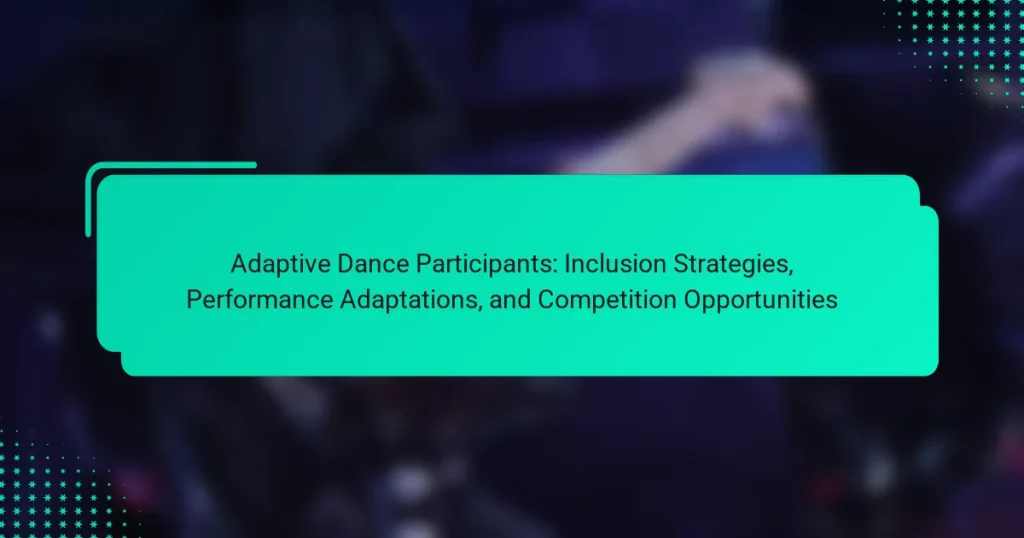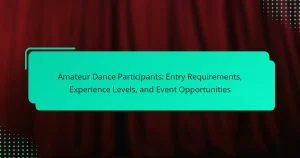Adaptive dance participants are individuals with disabilities who engage in specially designed dance programs that promote inclusivity and artistic expression. These programs enhance physical health, social skills, and emotional well-being through tailored instruction, flexible class structures, and accessible facilities. Performance adaptations, including choreography modifications and the use of assistive devices, ensure that all participants can express themselves effectively. Additionally, competitive opportunities in inclusive events foster skill development and community engagement, providing recognition for adaptive dancers. This article explores the strategies for inclusion, performance adaptations, and competition opportunities available for adaptive dance participants.
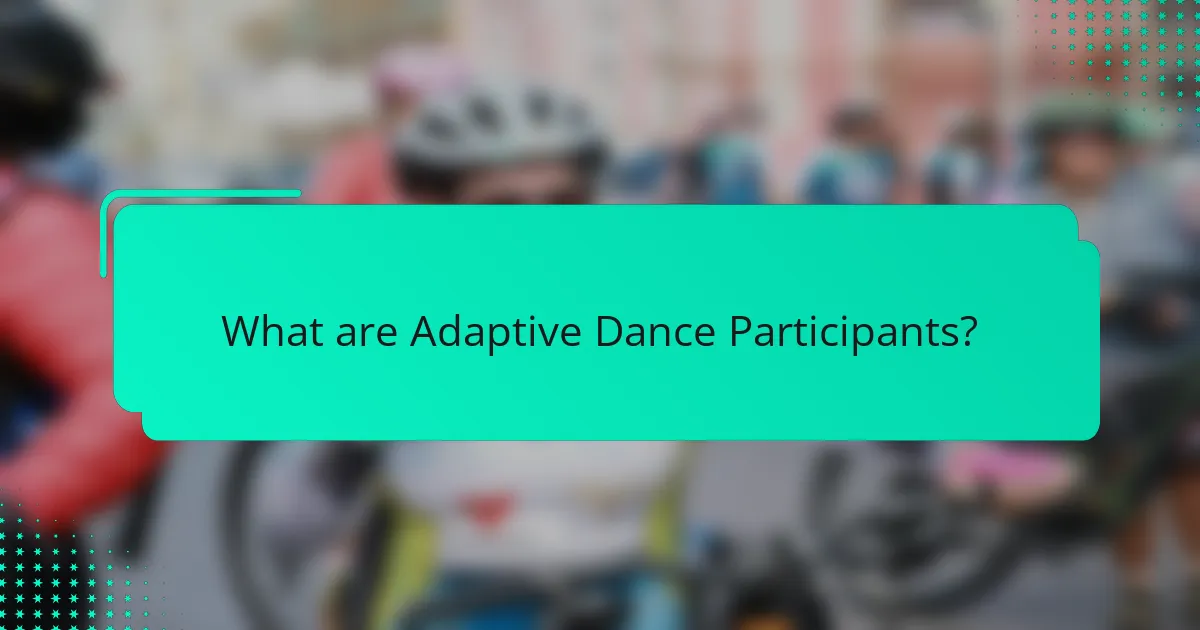
What are Adaptive Dance Participants?
Adaptive dance participants are individuals who engage in dance programs specifically designed for people with disabilities. These programs aim to promote inclusivity and provide opportunities for artistic expression. Adaptive dance allows participants to experience the joy of movement regardless of their physical or cognitive abilities. Research shows that adaptive dance can improve physical health, social skills, and emotional well-being. Programs often include modifications to traditional dance techniques to accommodate various needs. This ensures that all participants can enjoy and benefit from dance activities. Adaptive dance fosters a sense of community and belonging among participants.
How do Adaptive Dance Participants differ from traditional dancers?
Adaptive dance participants differ from traditional dancers primarily in their approach to movement and expression. Adaptive dance focuses on inclusivity, allowing individuals with varying abilities to participate. Traditional dancers often adhere to specific techniques and styles that may not accommodate physical limitations.
Adaptive dance incorporates modifications to techniques to suit individual needs. This can include the use of assistive devices or alternative movement patterns. Traditional dance typically follows established forms and choreography without such adaptations.
In adaptive dance, the emphasis is on personal expression and enjoyment rather than performance perfection. Traditional dance often prioritizes technical skill and competition readiness.
Research indicates that adaptive dance fosters social connections and boosts confidence among participants. A study by D. L. K. Smith et al. in “Journal of Dance Medicine & Science” highlights the positive impact of adaptive dance on participants’ mental health and social integration.
What are the various types of disabilities represented among Adaptive Dance Participants?
Adaptive Dance Participants represent various types of disabilities. These include physical disabilities such as mobility impairments and limb differences. Additionally, participants may have visual impairments that affect their sight. Some may also have hearing impairments, impacting their ability to hear music or instructions. Cognitive disabilities are represented as well, including conditions like autism spectrum disorder. Each type of disability requires specific adaptations in dance techniques and performance. Research indicates that adaptive dance promotes inclusion and enhances social interaction among diverse participants.
How does the background of Adaptive Dance Participants influence their performance?
The background of Adaptive Dance Participants significantly influences their performance. Factors such as physical ability, prior dance experience, and emotional support play critical roles. Participants with a history of dance often demonstrate improved technique and confidence. Those with physical disabilities may adapt movements uniquely, showcasing creativity. Emotional support from family or peers can enhance motivation and resilience. Research indicates that inclusive environments positively affect performance outcomes. Studies show that participants who feel accepted are more likely to engage fully. Overall, diverse backgrounds contribute to varied and enriched performances in adaptive dance.
Why is inclusion important for Adaptive Dance Participants?
Inclusion is crucial for Adaptive Dance Participants as it fosters a sense of belonging and empowerment. It allows individuals with diverse abilities to engage in creative expression through dance. This participation enhances their physical, emotional, and social well-being. Studies show that inclusive environments improve self-esteem and confidence. Furthermore, inclusion promotes understanding and acceptance among peers. It cultivates community connections and breaks down barriers. Research indicates that inclusive dance programs lead to increased participation rates. The benefits extend beyond the dance floor, impacting participants’ overall quality of life.
What are the social benefits of including Adaptive Dance Participants in dance programs?
Including Adaptive Dance Participants in dance programs fosters social inclusion and community engagement. This integration promotes diversity within the dance community. It enhances empathy and understanding among participants, breaking down barriers related to disability. Research shows that inclusive dance settings improve social skills and confidence in all dancers. A study published in the Journal of Dance Education found that adaptive dance programs significantly increase social interaction and cooperation among participants. Furthermore, these programs create a supportive environment, encouraging friendships and teamwork. Overall, including Adaptive Dance Participants enriches the social fabric of dance communities.
How does inclusion impact the mental health of Adaptive Dance Participants?
Inclusion positively impacts the mental health of Adaptive Dance Participants. It fosters a sense of belonging and community. Participants experience reduced feelings of isolation. Increased social interaction enhances emotional well-being. Studies show that inclusive environments boost self-esteem. They also promote resilience and coping skills. Research highlights improved mental health outcomes in diverse settings. For example, a study by McGowan et al. (2020) found that inclusive dance programs significantly decreased anxiety levels among participants. Overall, inclusion plays a crucial role in supporting the mental health of Adaptive Dance Participants.
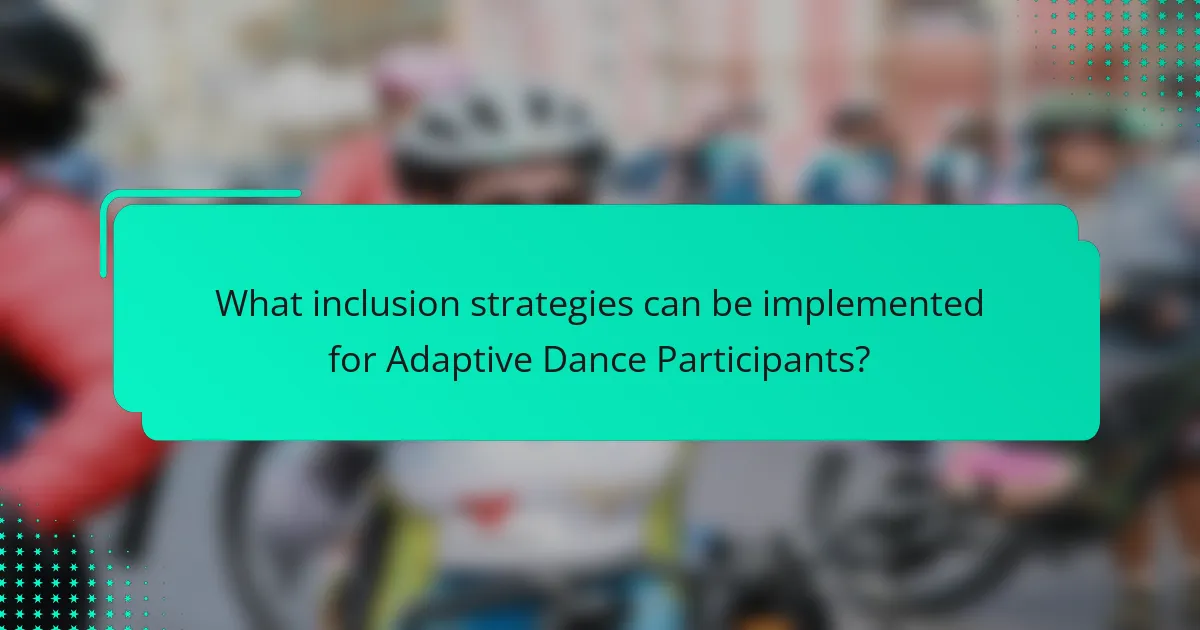
What inclusion strategies can be implemented for Adaptive Dance Participants?
Inclusion strategies for Adaptive Dance Participants include tailored instruction, flexible class structures, and accessible facilities. Tailored instruction ensures that dance techniques are adapted to each participant’s abilities. Flexible class structures allow for varying levels of participation and engagement. Accessible facilities provide necessary accommodations, such as ramps and specialized equipment.
Additionally, fostering a supportive community encourages peer interaction and collaboration. This promotes social inclusion and enhances the overall experience. Training instructors in adaptive techniques enhances their ability to meet diverse needs effectively. Research indicates that inclusive practices lead to improved outcomes for participants, both physically and socially.
How can dance studios create a welcoming environment for Adaptive Dance Participants?
Dance studios can create a welcoming environment for Adaptive Dance Participants by ensuring accessibility and inclusivity. This includes physical access to the studio with ramps and wide doorways. Staff training is essential to equip instructors with knowledge about adaptive techniques. Creating a supportive community fosters relationships among participants. Offering tailored classes accommodates varying abilities and needs. Clear communication about class expectations builds confidence for participants. Regular feedback from adaptive dancers helps refine the program. Collaboration with local organizations can enhance resources and outreach. These strategies collectively improve the experience for Adaptive Dance Participants.
What training should instructors receive to effectively work with Adaptive Dance Participants?
Instructors should receive specialized training in adaptive dance techniques. This training should include understanding various disabilities and their impact on movement. Knowledge of inclusive teaching practices is essential. Instructors should also learn how to modify dance styles for different abilities. Training should cover communication strategies for effective interaction with participants. Additionally, instructors need to understand safety protocols specific to adaptive dance. Workshops on creating inclusive environments are beneficial. Practical experience through working with adaptive dance participants is crucial for effective instruction.
How can adaptive equipment enhance the experience for Adaptive Dance Participants?
Adaptive equipment enhances the experience for Adaptive Dance Participants by providing tailored support and accessibility. This equipment includes specialized wheelchairs, harnesses, and dance aids. Such tools enable participants to engage in dance forms that align with their abilities. They promote independence and encourage creative expression. Research shows that adaptive equipment can improve physical coordination and confidence in participants. For instance, a study published in the Journal of Dance Medicine & Science found that adaptive dance programs significantly increased participants’ mobility and self-esteem. This evidence highlights the positive impact of adaptive equipment on the overall dance experience for individuals with diverse needs.
What role do community partnerships play in supporting Adaptive Dance Participants?
Community partnerships play a crucial role in supporting Adaptive Dance Participants. These collaborations provide essential resources and opportunities for participants. Local organizations often offer funding, space, and equipment necessary for dance programs. Additionally, partnerships enhance visibility and awareness of adaptive dance within the community. This increased awareness can lead to more participants joining and benefiting from the programs. Research shows that community involvement improves the overall success and sustainability of adaptive dance initiatives. By fostering connections, partners can also facilitate inclusive events and performances that showcase the talents of Adaptive Dance Participants. These efforts ultimately create a more supportive environment for individuals with diverse abilities to thrive in dance.
How can local organizations collaborate to promote adaptive dance initiatives?
Local organizations can collaborate to promote adaptive dance initiatives by forming partnerships and sharing resources. They can host joint workshops that focus on adaptive techniques. This allows for knowledge exchange among instructors and participants. Organizations can also create inclusive performance opportunities together. By pooling funding, they can support specialized programs. Additionally, they can engage in community outreach to raise awareness about adaptive dance. Collaboration can lead to a stronger network that advocates for inclusivity in the arts. Research indicates that community partnerships enhance program effectiveness and participant engagement.
What funding opportunities exist for programs focused on Adaptive Dance Participants?
Funding opportunities for programs focused on Adaptive Dance Participants include grants from arts organizations, government funding, and private donations. Many arts councils and foundations, such as the National Endowment for the Arts, offer grants specifically for inclusive dance programs. Local community grants may also be available through municipalities or regional arts agencies. Organizations like Dance/NYC provide resources and funding specifically aimed at enhancing access for disabled dancers. Additionally, crowdfunding platforms can be utilized to raise funds directly from supporters. Foundations such as the Christopher & Dana Reeve Foundation offer grants for programs that promote adaptive sports and arts. These funding sources support initiatives that foster inclusion and provide necessary resources for adaptive dance programs.
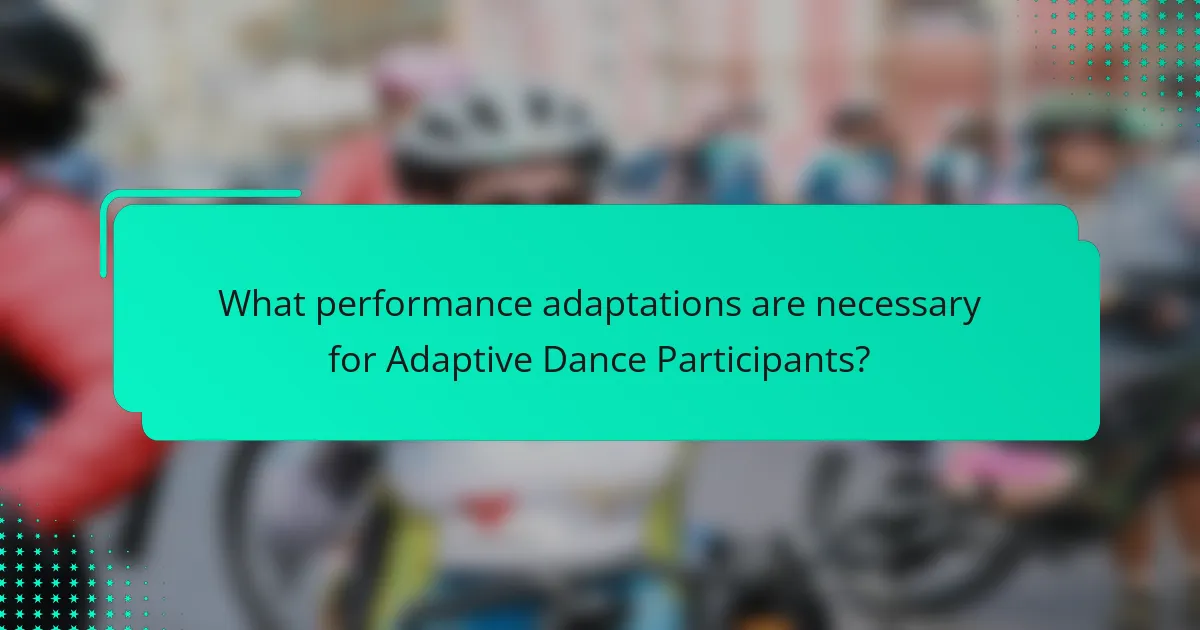
What performance adaptations are necessary for Adaptive Dance Participants?
Performance adaptations for Adaptive Dance Participants include modifications in choreography, use of assistive devices, and tailored training methods. Choreography should be flexible to accommodate various abilities. This allows dancers to express themselves effectively. Assistive devices, such as wheelchairs or crutches, may be integrated into performances. These devices enable participation for individuals with mobility challenges. Training methods must be personalized, focusing on individual strengths and limitations. This ensures that each participant can achieve their best performance. Additionally, the environment should be accessible, allowing for safe movement and interaction. These adaptations foster inclusivity and enhance the overall dance experience for all participants.
How can choreography be modified for different abilities in Adaptive Dance?
Choreography in Adaptive Dance can be modified by adjusting movements to fit various abilities. This includes simplifying complex steps for those with limited mobility. Using props can enhance participation, allowing dancers to engage at their own level. Incorporating different tempos can accommodate varying physical capabilities. Additionally, offering options for seated or standing positions can ensure inclusivity. Collaborating with participants helps tailor choreography to individual strengths and preferences. Research indicates that personalized adaptations increase engagement and enjoyment in dance activities. These modifications foster a supportive environment for all dancers, promoting creativity and expression.
What are the key considerations when creating inclusive dance routines?
Key considerations when creating inclusive dance routines include accessibility, diverse representation, and adaptability. Accessibility ensures that routines accommodate various physical abilities. This can involve modifying movements or using assistive devices. Diverse representation involves incorporating dancers from different backgrounds and abilities. This enriches the performance and promotes inclusivity. Adaptability allows routines to be adjusted based on individual needs. For instance, varying the tempo or complexity of movements can cater to different skill levels. These considerations enhance participation and foster a supportive environment for all dancers.
How can technology assist in performance adaptations for Adaptive Dance Participants?
Technology can assist in performance adaptations for Adaptive Dance Participants by providing tailored tools and resources. Wearable devices can monitor physical capabilities and provide real-time feedback. This feedback helps dancers adjust their movements for optimal performance. Virtual reality can simulate dance environments, allowing participants to practice in a safe space. Additionally, adaptive software can customize choreography to suit individual needs. These technological solutions enhance accessibility and engagement in dance. Research indicates that such adaptations improve overall performance and confidence in participants. For instance, a study by Hurst et al. (2021) found that technology integration in adaptive dance significantly increased participant satisfaction and skill development.
What are some examples of successful performance adaptations in Adaptive Dance?
Successful performance adaptations in Adaptive Dance include the use of wheelchair dance, which allows dancers with mobility impairments to participate. Another example is the incorporation of sign language interpretation, enabling deaf dancers to engage fully in performances. Additionally, sensory-friendly adaptations, such as adjusted lighting and sound levels, create an inclusive environment for individuals with sensory sensitivities. The integration of assistive technology, like motion sensors, enhances the dance experience for participants with disabilities. Programs that offer personalized choreography also demonstrate successful adaptations, catering to individual strengths and abilities. Each of these adaptations has been shown to increase participation and enjoyment among dancers with diverse needs.
How do these adaptations enhance the overall performance experience?
Adaptations in adaptive dance enhance the overall performance experience by providing tailored support for participants. They allow individuals with diverse abilities to engage fully in dance. These adaptations may include modified movements, specialized equipment, and adjusted choreography. Such changes ensure that all participants can showcase their skills effectively. Research shows that inclusive practices boost confidence and enjoyment among dancers. Enhanced performance experiences lead to greater emotional expression and connection with the audience. Ultimately, these adaptations foster a sense of belonging and achievement in the dance community.
What feedback have Adaptive Dance Participants provided regarding performance adaptations?
Adaptive Dance Participants have provided positive feedback regarding performance adaptations. They appreciate modifications that enhance accessibility and comfort. Many participants highlight the importance of individualized adjustments to suit their unique needs. Feedback indicates that adaptive techniques help improve their overall experience. Participants report increased confidence and enjoyment when adaptations are implemented. They also express gratitude for instructors who are responsive to their feedback. Overall, the feedback emphasizes the value of tailored performance adaptations in fostering inclusion and participation.
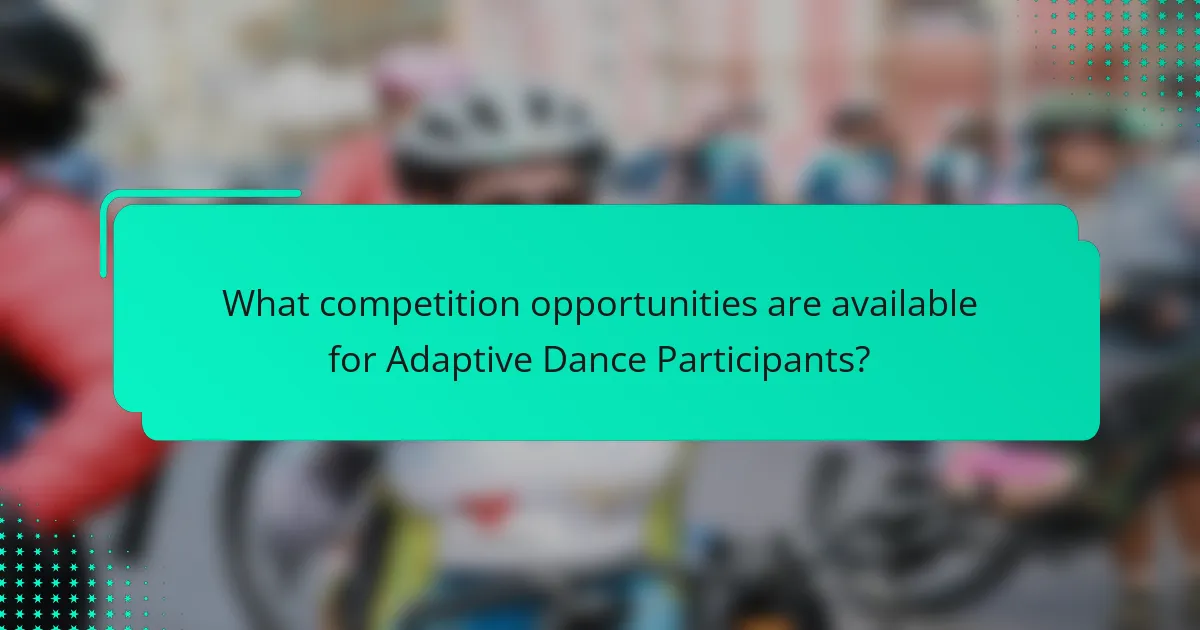
What competition opportunities are available for Adaptive Dance Participants?
Adaptive Dance Participants can compete in various events designed for inclusivity. These competitions often include categories specifically for dancers with disabilities. Organizations such as the International Dance Organization (IDO) host events that welcome adaptive dancers. Additionally, local dance competitions may offer adaptive categories to promote participation. Some festivals focus solely on showcasing adaptive dance performances. These opportunities encourage skill development and community engagement. Many competitions also provide awards and recognition for participants. This fosters a supportive environment for adaptive dancers to shine.
How can Adaptive Dance Participants prepare for competitions?
Adaptive Dance Participants can prepare for competitions by focusing on skill development, physical conditioning, and mental preparation. Regular practice sessions enhance dance techniques and improve performance quality. Participants should work on specific routines that will be performed during the competition. Engaging in strength and flexibility training builds physical endurance and reduces injury risk. Mental preparation, including visualization techniques, helps participants manage competition anxiety. Additionally, understanding the competition rules and criteria ensures compliance and boosts confidence. Collaborating with instructors for feedback and guidance further refines performance.
What specific skills should be developed for competitive adaptive dance?
Competitive adaptive dance requires several specific skills. These include body awareness, which helps dancers understand their movements and spatial orientation. Coordination is essential for synchronizing movements with music and partners. Balance is crucial for maintaining stability during various dance forms. Flexibility enhances a dancer’s range of motion, allowing for more expressive movements. Strength is necessary to support the body during dance routines. Communication skills are vital for effective interaction with partners and judges. Adaptability enables dancers to modify techniques to suit their individual needs. Finally, emotional expression is important for conveying feelings through dance. These skills collectively contribute to a dancer’s performance quality and competitive success.
How do judges evaluate performances by Adaptive Dance Participants?
Judges evaluate performances by Adaptive Dance Participants based on several criteria. These criteria include technical skill, artistic expression, and overall presentation. Judges assess the execution of movements, including precision and control. They also consider the emotional connection conveyed through the performance. Adaptations made for individual needs are recognized and valued. Judges look for creativity in choreography that suits the participant’s abilities. Scoring may also reflect the level of difficulty of the performance. The goal is to provide a fair assessment that acknowledges each participant’s unique contributions.
What are some notable competitions for Adaptive Dance Participants?
Notable competitions for Adaptive Dance Participants include the National Dance Competition and the Dance Ability International Festival. These events provide platforms for dancers with disabilities to showcase their talents. The National Dance Competition features categories specifically for adaptive dancers. The Dance Ability International Festival promotes inclusivity in dance through workshops and performances. Both competitions emphasize the importance of representation in the dance community. They also encourage artistic expression among participants. Participation in these events can enhance visibility and support for adaptive dance.
How can participation in competitions benefit Adaptive Dance Participants?
Participation in competitions can significantly benefit Adaptive Dance Participants. It fosters a sense of achievement and boosts self-esteem. Competing allows participants to showcase their skills and creativity. This exposure can lead to greater recognition within the dance community. Competitions also encourage social interaction among participants. They provide opportunities for networking with peers and professionals. Furthermore, these experiences can enhance motivation to improve dance techniques. Research indicates that performance opportunities can lead to increased physical and emotional well-being for individuals with disabilities.
What success stories exist among Adaptive Dance Participants in competition settings?
Adaptive Dance Participants have achieved notable success in competition settings. Many participants have won awards at regional and national dance competitions. For example, the “Dancing with the Stars” program has featured adaptive dancers who showcased their talents alongside able-bodied performers. Competitions like “The Dance Awards” have recognized adaptive dance categories, allowing participants to compete on equal footing. Additionally, some adaptive dancers have been invited to perform at prestigious events, enhancing visibility for adaptive dance. These achievements demonstrate the growing acceptance and celebration of adaptive dance in competitive environments.
What best practices can enhance the experience for Adaptive Dance Participants?
To enhance the experience for Adaptive Dance Participants, implement individualized instruction tailored to each dancer’s needs. This approach fosters inclusivity and ensures that all participants can engage meaningfully. Incorporating adaptive techniques and equipment, such as specialized wheelchairs or supportive harnesses, further facilitates participation. Creating a supportive environment encourages social interaction and builds community among dancers. Regular feedback sessions allow participants to voice their experiences and preferences, leading to continuous improvement. Training staff on disability awareness and adaptive methods promotes a more inclusive atmosphere. Finally, showcasing diverse performances can inspire and validate the experiences of Adaptive Dance Participants. Research indicates that such practices significantly improve participant satisfaction and engagement in dance programs.
Adaptive dance participants are individuals with disabilities who engage in dance programs tailored for inclusivity and artistic expression. The article explores inclusion strategies, performance adaptations, and competition opportunities within adaptive dance, highlighting the importance of personalized instruction and supportive environments. It details various disabilities represented among participants and emphasizes the positive impact of adaptive dance on physical, emotional, and social well-being. Additionally, the article discusses the role of community partnerships, funding opportunities, and best practices to enhance the experience for adaptive dancers, showcasing successful adaptations and notable competition events.
